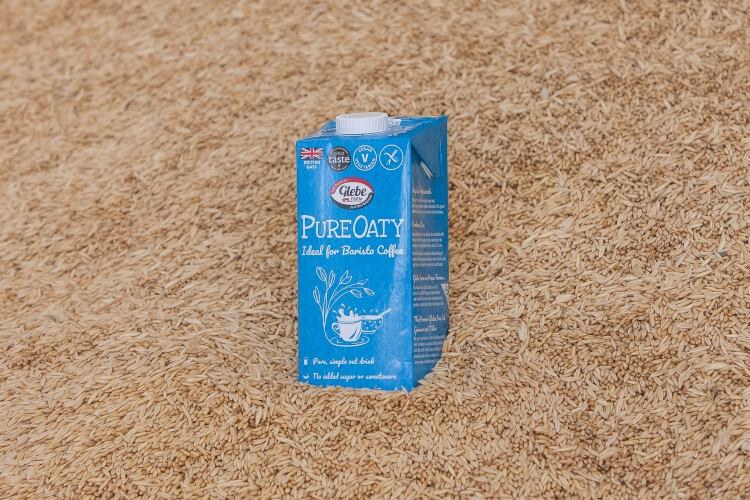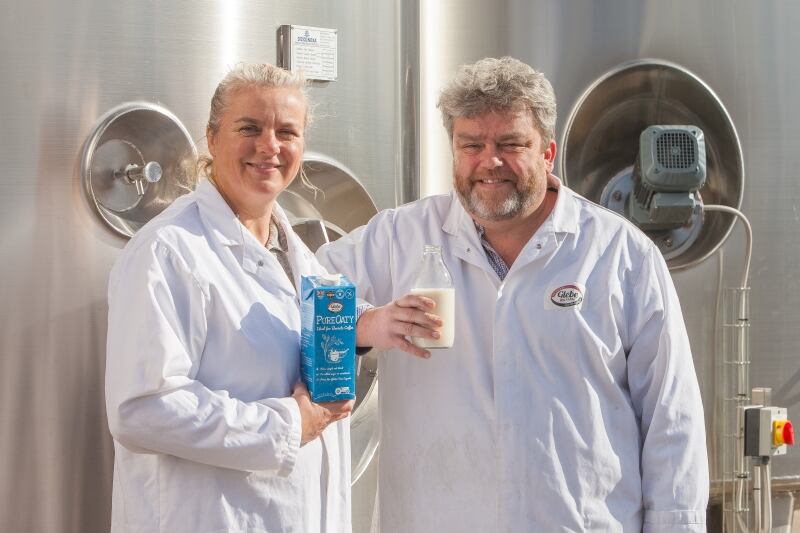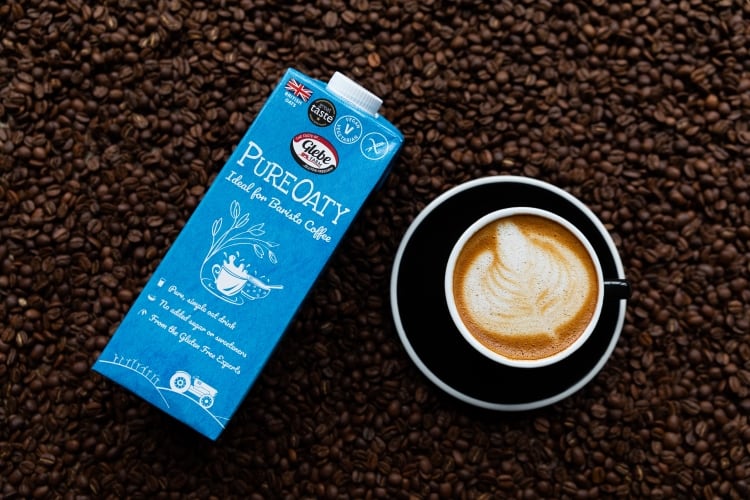A recent study from Mintel showed up to one in three Brits now drink plant-based milk alternatives, with oat officially becoming the UK’s plant-based milk alternative of choice with the market now worth £146m ($199m).
According to oat beverage producer Glebe Farm, while 92% of UK consumers prefer to buy dairy alternatives made using UK ingredients and 60% of Brits say product provenance is a priority, the majority of vegan products sold in the UK are made using ingredients traveling long distances across Europe to reach supermarket shelves.
To ensure British produce stands out on shelf alongside the growing amount of plant-based competitors shipped from overseas, Glebe Farm owner Phillip Rayner told Dairy Reporter retailers should ensure the provenance of each product is clearly visible.

Rayner said Glebe Farm, which has a plant in the UK, ensures its oat drinks are made from UK oats, which means its products have lower food miles compared to other dairy alternative providers.
The importance of highlighting environment credentials is continuing to grow as consumers are becoming increasingly conscious of their purchasing habits. Rayner said clearly communicating a brand’s sustainability efforts, such as through packaging, helps stand out from competitors.
He said companies also need to be transparent on ingredients, providing clear and concise food labeling, which is becoming crucial for foodservice and retailers.
This is especially important when considering food intolerances, as there is a growing gluten-free market with more people identifying an intolerance to gluten or choosing gluten-free foods. Rayner said many consumers assume oat products are naturally gluten-free, however this is not the case. Most oats are often grown near wheat and processed in facilities that also handle wheat products, so Rayner said they are frequently cross-contaminated with gluten.
Transparency and clarity are therefore key for those who require a gluten-free lifestyle. Glebe Farm PureOaty is made from four natural ingredients: British gluten-free oats, water and salt, which Rayner said makes the short list of ingredients attractive to anyone looking for a product that can be trusted to be gluten free. This type of information can be displayed via signage provided by producers and displayed clearly for consumers.
In addition to clear communication, whether for environmental credentials or ingredients, Rayner said a key method for brands to keep ahead of the competition is through strong marketing initiatives, which enable brands to communicate and land their key messages to consumers, shifting perception and in turn driving sales.
We had the opportunity to put some questions to Rayner about the growth of plant-based dairy alternatives.

Are all plant milk alternatives equal when it comes to sustainability, ingredients?
It couldn’t be further from the truth to suggest that all plant-based milk alternatives are equally sustainable. Whereas oats are a crop that grows successfully in the UK, and with relatively low intervention in terms of irrigation and fertilizer, that cannot be said for many of the options on the market where the core ingredient often needs to travel for hundreds of miles to reach the British consumer.
Additionally - even though oats are an excellent British crop – the majority of oat drinks on UK shelves are imported from the continent, thereby incurring unnecessary and unsustainable food miles. A study commissioned by Glebe Farm uncovered that most plant based drink consumers would like to buy British... but only a minority are checking the label to make sure.
In fact whilst 92% of UK consumers insist they prefer to buy dairy alternative milk made using UK ingredients and 60% of Brits adding that product provenance is a priority, the majority of these vegan products sold in the UK are made using ingredients that have traveled enormous distances across Europe to reach supermarket shelves. This severely undermines the intentions of switching to plant based milks for sustainability purposes, because British shoppers are yet to grasp the food miles that most non-dairy alternatives travel in order to
reach UK shops.
Would labeling of carbon footprints prove to be useful and, if so, how can this be implemented?
The labeling of carbon footprint represents a level of transparency that could benefit both environmentally conscious consumers and sustainable producers. As such it’s a tool that companies are using - and one that Glebe Farm promotes through a QR code on its pack driving to a comprehensive online report – but that’s not to say it’s straightforward.
Firstly, it can be an expensive process to commission an independent third party to undertake the complex process of carbon life cycle analysis, and this can be prohibitive to all but the largest players. Glebe Farm ultimately did undertake the necessary research such was its confidence in achieving its market-beating low result, but – although adoption of these processes is becoming more common - it is a factor inhibiting widespread adoption.
In the absence of a standardized industry method of reporting these figures (akin to a nutritional traffic light system) variation in metrics and level of clarity may vary, sowing the seeds of doubt and confusion amongst customers and the public.
In order for the labelling to be effective, companies must make it concise and to the point, ensuring the copy is consumer friendly and easy to digest. This in turn, would force companies to take greater environmental consideration into their actions at each stage of production, keeping up with competitors within the increasingly saturated market.
Glebe Farm is proud to reveal best-in-class carbon emission figures for their UK produced Oat Drink with its report commissioned through NFU Energy found that just 0.29kg of CO2 equivalent is emitted on average per litre of PureOaty oat drink produced, lower than any other oat drink currently reporting comparable figures in the UK.
The shelves – both chilled and ambient – are filled with more and more plant-based beverages. On-pack labels are one thing, but most consumers are first drawn to the packaging itself before reading in more detail – how do brands ensure they are the ones picked up (i.e. before people get to the ingredients list)?
To stand out from competitors, ensuring their product is picked up first, it is important for a brand to be established at the forefront of consumers' minds even before entering a shop.
A key method for brands to achieve this and keep ahead of the competition is through strong marketing initiatives that enables brands to land their key messages and embed emotional and visual associations that resurface at the all-important point of purchase. Strong and creative marketing allows a brand to differentiate itself, particularly within a competitive arena.
Effective marketing is not only about paid tactics to get advertising messages in front of consumers, it’s about identifying what the audience are looking for and shaping the story that surrounds a brand at every touchpoint – including social media and word-of-mouth.
The visual impact of the pack is then the last fundamental in that process, and on-shelf the product must be eye-catching and entirely in keeping with the associations that the consumer has for your product. Any incongruity could lead to doubt, and ultimately many consumers simply opt for the ‘safe’ choice of the familiar market leader who is typically intuited to be least likely to disappoint.
As we know, the safe choice is rarely the best, and the job for a brand like Glebe Farm PureOaty is to be clear and impressive enough that it overrides this all-too-common auto-pilot effect! Once trialled, taste and performance can sing through and the customer is more likely to pick you consistently in the future.
How important is social media in conveying information?
Social media has significantly shifted the ways companies operate, including how they can communicate brand messaging. Social media provides an impactful and efficient direct service to consumers, where brands can now reach out to their target market, 24/7 and free of charge, to communicate any form of messaging they want their consumers to hear, whether this be new product launches, environmental efforts or the storytelling of the
company.
Social media is therefore a fundamental necessity to consider within a company, and is only set to grow. However, despite the huge benefits of social media to build a business, including driving sales and brand awareness, social media can be a risky tool if not used with caution. Bad publicity spreads quickly via social channels and backlash can often form as a result of unsatisfied customers. However, companies can quickly communicate feedback and deal directly with their customers to efficiently solve issues, building a strong
rapport with their market.
Social media is therefore incredibly important to consider within a brand, both for how a brand can utilize and capitalize on the tool, but also the risks the vulnerable platform provides for a business.
Are on-pack QR codes that drive people to websites for more information useful?
We certainly hope so as that has been Glebe Farm’s approach!
Firstly, they indicate confidence in sustainability credentials, and there is only so much information that can fit on pack and a matter of this complexity and importance demands substantiation with the fuller story somewhere that allows the space and time for it – i.e. online.
The covid epidemic has massively increased the use of QR codes for everyone so adoption is increasing and hopefully this is a way for customers to be better informed when they want to take that step to find out more and look beyond the simple soundbites that can fit on a small pack.
Prices for dairy alternatives vary wildly, what’s the key to push them lower to compete with dairy?
At the moment dairy alternatives are a specialized market requiring new technologies and process a fair degree of research and development to perfect. It is not easy to develop a plant milk that works, and Glebe Farm pulls on decades of R&D with its partners in order to create oat drinks that can sit alongside the functional benefits of milk, such as performing in acidic hot drinks such as coffee just as well as smoothies or on cereals.
There’s a key other point – dairy is at a limiting point where margins are razor thin and whether dairy can continue to operate at this level over the long term is of course also a moot point.

